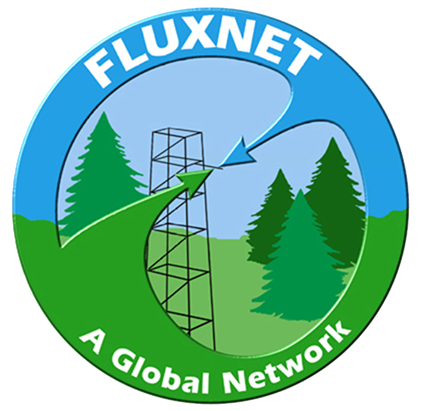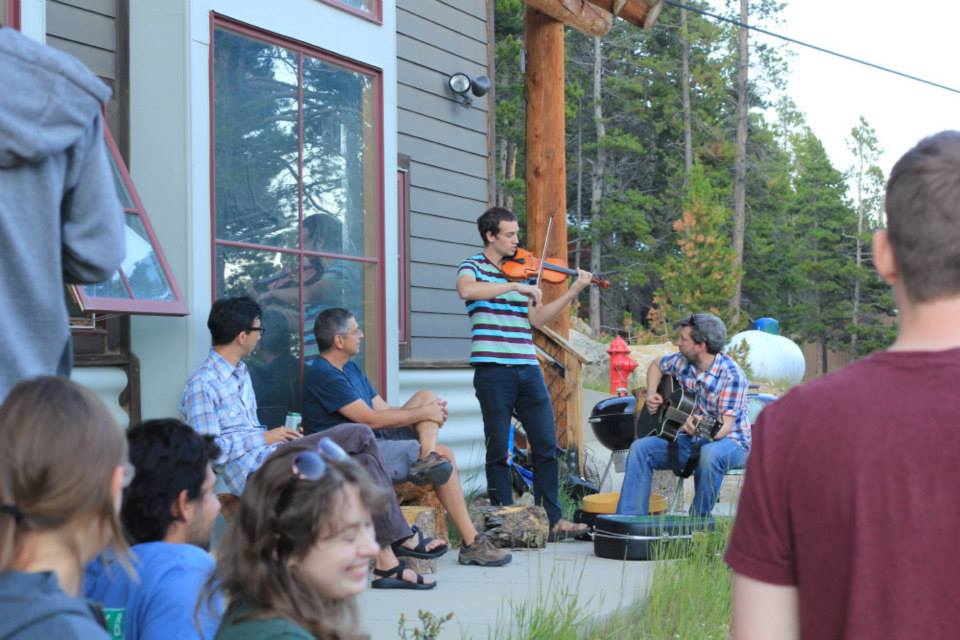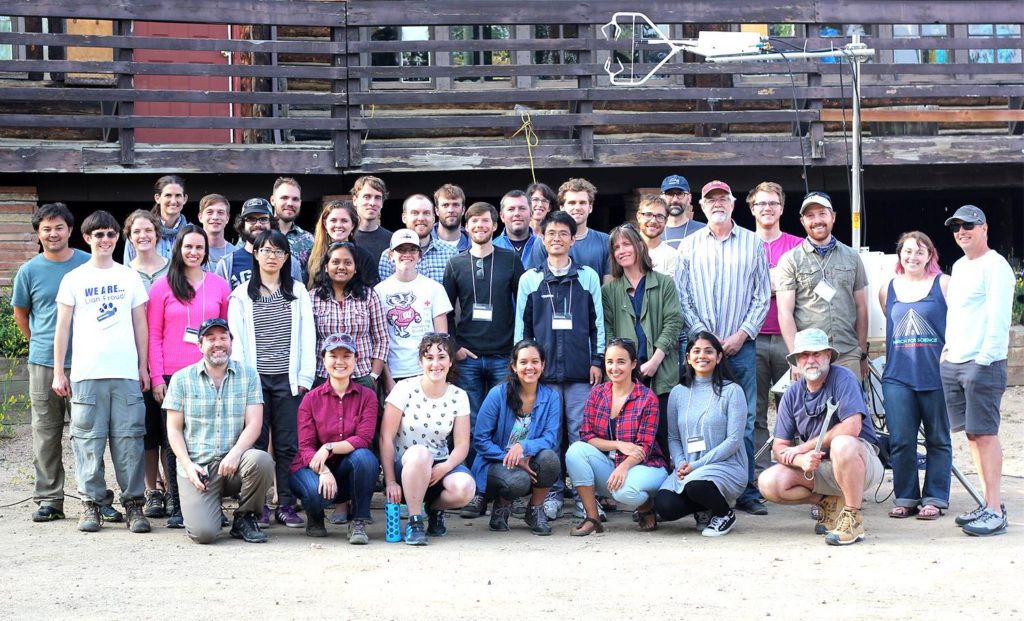The fluxcourse is a summer school focusing on land-atmosphere fluxes and it takes place each summer at the University of Colorado Mountain Research Station. You can still apply for this year’s 12th edition (July 13-27 2019) until March 15th. This month, the organizers Kim Novick (Indiana University Bloomington) and Dave Moore (University of Arizona) will tell us more about the fluxcourse and about the memorable moments that have shaped the history of the summer school.

Caitlin Moore (now University of Illinois) explaining an eddy covariance tower setup at the fluxcourse 2015 (Photo: Ed Swiatek)
Can you give us a little bit of background on the fluxcourse? When and how did the fluxcourse start and who initiated it?

Russ Monson delivering his “Monson’s Musings” on the history of C4 photosynthesis (Photo: Kim Novick)
This is really a question for Russ Monson and Dave Schimel. They were the ones who got it going. The story goes that Russ and Dennis Baldocchi were having a discussion about how to help train the next generation of flux scientists. The idea for the fluxcourse was floated and Russ and Dave requested funds from NSF Biocomplexity (a precursor to Macrosystems). The fluxcourse has always been a coalition of the willing. Everyone who teaches is a volunteer. The first year of the course we had lots of contributors including Ray Leuning, Marcy Litvak, Dennis Baldocchi, Jielun Sun and Dave Moore. The next year Dave Schimel was busy getting NEON going and so Russ asked Dave to help organise the second week of the course. It remained that way for several years until Kim Novick took over Russ Monson’s role. In 2018 we had a great fluxcourse retreat at the Ameriflux meeting where we re-invigorated the course by recruiting several new instructors, and discussing ways to refresh the syllabus for the course’s second decade. That task is now being executed by the Fluxcourse Curriculum Committee, which is comprised of Dario Papale, Ankur Desai, Claire Lunch, Marcy Litvak, Danica Lombardozzi, Xi Yang, Debjani Sihi, Dave and Kim.
For whom could the fluxcourse be interesting? At what stage of career is the summer school targeted?
We target “early career scientists” – but we interpret this broadly. We try to balance the course in terms of age and experience – some applicants are already excellent scientists, others are just starting out. We have students just starting their MSc, PhD students, postdocs and Assistant Professors. Often applications come from folks who don’t have the opportunity to take a course like this at their institution. Sometimes we have an overwhelming number of applicants – we try to balance the expertise within the applicants – it’s best to have about half the students who have some exposure to observations and half who have some knowledge of modeling or coding. This helps people learn from each other. We are always sad to turn away applicants, but we try to keep the numbers at about 24-26 so that all the attendees get to know one another and get to interact with the instructors if the wish.
What will participants take home from this summer school?
Because people come in with a range of expertise, we think everyone takes home something different. The big educational goal of the course is to help early career scientists cross over between measurements, synthesis and modeling – to help them understand these different scientific approaches.
We cover the fundamentals of measuring fluxes, synthesis of fluxes and modeling. We tend to focus on carbon, water and energy, but in recent years instructors have started to discuss other trace gasses.
Over the years, we have asked participants what they take away – usually they remember the people that they met there and the collaborations they formed. Because the course lasts for two weeks, and is held in a remote location, students have a great opportunity to form lasting connections with each other, and the instructors.
What was the most memorable moment in all the years? Were there difficult/challenging moments?
Oh there have been a few. We made Russ Monson stay in a haunted house once! One participant fell out of a top bunk causing consternation. Ray Leuning provided several! But the most memorable event was probably the Cold Springs fire of 2016. On the day that students were arriving to Fluxcourse, this wildfire erupted in a forested area between Boulder and the CU Mountain Research Station at Niwot Ridge (where the course is held). The station had to be evacuated, leaving us with no venue for the course. It usually takes months of careful planning to get the fluxcouse organized, and suddenly we were in the position of having to reorganize it in 24 hours. The folks at CU hospitality services were wonderful and everyone was a good sport but .. yes … that was memorable!
Where did the past participants come from and where are they now? Do you keep track of the fluxcourse alumni?
The participants come from all over the world. In a given years we can have participants from 10-12 different countries and there’s always enough to have a “USA vs the rest of the world” beach volleyball match. Some of the same labs send participants year after year but we also love welcoming new research groups into field – we are trying to actively recruit.
We don’t keep a list, but we do run into many alumni. At one very “fluxy” poster session at AGU a couple of years ago, it seemed that every poster was being presented by a Fluxcourse Alum – but from many different years. Many alumni have stayed in the field and we see them at conferences. Several have returned as instructors – something we are really grateful for. We can’t claim much credit for the success of the Alumni – all the participants were great before they attended fluxcourse – but we hope the experience helps them on their way.
Why choosing the Niwot Ridge location as a venue?
Well it’s pretty! Niwot was the initial setting because Russ and Dave Schimel were both based in Boulder. Later when Russ and Dave Moore were based in Arizona we considered moving the location but Niwot has some great features – first the folks who run the Mountain Research Station are wonderful – Bill Boman and his many helpers over the years have made us feel welcome and supported what we are trying to do at the course. It’s a beautiful setting with a flux tower and a NEON site all in close proximity; many participants, especially those who live outside the US, are stunned by how fantastic the Colorado Rockies are. And lastly – it’s a little remote – participants get a chance to really interact with each other after the course work is done for the day.
Do you have any new plans for the fluxcourse in the upcoming years?
We do! We have a brand new curriculum committee who are working on updating the measurements and modeling sections and we are formally adding a synthesis section. Now that flux towers have been running for 2 decades and can be found all over the world, we have profound opportunities to deepen our understanding of long-term drivers of fluxes, and how these vary across space.
Is there any financial support for students to participate in the summer school?
We are fundraising to try to increase support for those who can’t afford the fees and travel. We received an anonymous donation in 2018 to support this effort. Also we are very grateful to Ameriflux who support the fees of two participants each year and to those who have supported students in the past.


